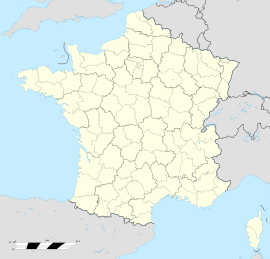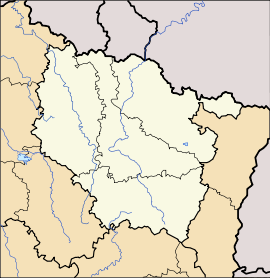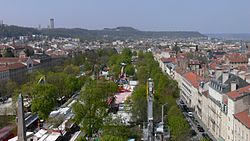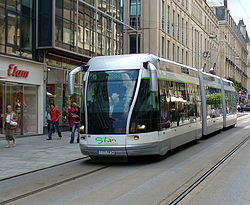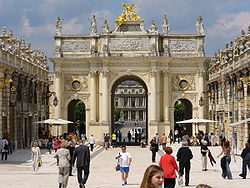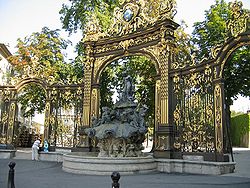- Nancy, France
-
This article is about the city in France. For other uses, see Nancy (disambiguation).
Nancy
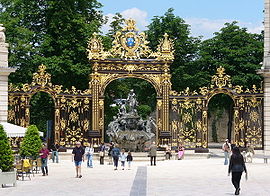
Place Stanislas – Fountain of Amphitrite 
Administration Country France Region Lorraine Department Meurthe-et-Moselle Arrondissement Nancy Intercommunality Greater Nancy Mayor André Rossinot (PR)
(2008–2014)Statistics Elevation 188–353 m (617–1,158 ft)
(avg. 212 m/696 ft)Land area1 15.01 km2 (5.80 sq mi) Population2 105,400 (2005) - Density 7,022 /km2 (18,190 /sq mi) INSEE/Postal code 54395/ 54000 Website http://www.nancy.fr/ 1 French Land Register data, which excludes lakes, ponds, glaciers > 1 km² (0.386 sq mi or 247 acres) and river estuaries. 2 Population without double counting: residents of multiple communes (e.g., students and military personnel) only counted once. Coordinates: 48°41′37″N 6°11′05″E / 48.6936°N 6.1846°E
Nancy (French pronunciation: [nɑ̃si]) is a city in the north-eastern French department of Meurthe-et-Moselle, and formerly the capital of the Duchy of Lorraine, and then the French province of the same name.
The city is the head of the department. The metropolitan area of Nancy had a population of 410,509 inhabitants at the 1999 census, 103,602 of whom lived in the city of Nancy proper (105,100 inhabitants in the city proper as of 2004 estimates).
The motto of the city is Non inultus premor, Latin for "No one touches me with impunity" a reference to the thistle, which is a symbol of Lorraine.
Contents
History
The earliest signs of human settlement in the area date back to 800 BC. Early settlers were likely attracted by easily mined iron ore and a ford in the Meurthe River. A small fortified town named Nanciacum (Nancy) was built by Gerard, Duke of Lorraine around 1050.
Nancy was conquered by Emperor Frederick II in the 13th century, then rebuilt in stone over the next few centuries as it grew in importance as the Capital of the Duchy of Lorraine. Charles the Bold, Duke of Burgundy, was defeated and killed in the Battle of Nancy in 1477.
With the death of the last Duke Stanislas in 1766, the duchy became a French province and Nancy remained its capital.
As unrest surfaced within the French armed forces during the French Revolution, a full-scale mutiny took place in Nancy in later summer 1790. A few reliable units laid siege to the town and shot or imprisoned the mutineers.
In 1871, Nancy remained French when Prussia annexed Alsace-Lorraine. The flow of refugees reaching Nancy doubled its population in three decades. Artistic, academic, financial and industrial excellence flourished, establishing what is still the Capital of Lorraine's trademark to this day.
Nancy was freed from Nazi Germany by the U.S. Third Army in September 1944, during the Lorraine Campaign of World War II (see Battle of Nancy (1944)).
In 1988, Pope John Paul II visited Nancy. In 2005, French President Jacques Chirac, German Chancellor Gerhard Schröder and Polish President Aleksander Kwaśniewski inaugurated the renovated Place Stanislas.
Geography
The neighboring communes of Nancy are: Jarville-la-Malgrange, Laxou, Malzéville, Maxéville, Saint-Max, Tomblaine, Vandœuvre-lès-Nancy and Villers-lès-Nancy.
Main sights
The Place Stanislas[1] named after the king of Polish-Lithuanian Commonwealth and duke of Lorraine Stanisław Leszczyński, Place de la Carrière, and Place d'Alliance were added on the World Heritage Sites list by the UNESCO in 1983.
The "École de Nancy", a group of artists and architects founded by the glassmaster and furniture maker Émile Gallé, worked in the Art Nouveau style at the end of the 19th century and the early 20th century. It was principally their work which made Nancy a centre of art and architecture that rivaled Paris and helped give the city the nickname "Capitale de l'Est." The city still possesses many Art Nouveau buildings (mostly banks or private homes). Furniture, glassware, and other pieces of the decorative arts are conserved at the Musée de l'École de Nancy, which is housed in the 1909 villa of Eugène Corbin, a Nancy businessman and supporter of the Art Nouveau there.
The old city centre's heritage dates from the Middle Ages to the 18th century. The cathedral of Nancy, the Triumphal Arch and the "Place de la Carriere" are a fine examples of 18th century architecture.[2] The surroundings of the train station are a busy commercial area.
A major botanical garden, the Jardin botanique du Montet, is located at Villers-lès-Nancy. Other gardens of interest include the city's earliest botanical garden, the Jardin Dominique Alexandre Godron, and various other public gardens and places of interest including the Pépinière and Parc Sainte-Marie (public gardens).
There is also the aquarium, the Musée de l'École de Nancy, the Musée des Beaux-Arts and the Musée Lorrain amongst others.
 A panoramic view of Place Stanislas
A panoramic view of Place Stanislas
Culture
The city is known for its World Heritage buildings: The Place Stanislas (XVIII°) which was opened April 2005 by Jacques Chirac after refurbishment.
At the turn of the 20th century, Nancy was a major centre of the Art Nouveau with the École de Nancy. The city possess a unique and interesting Musée de l'École de Nancy (School of Nancy Museum) with artworks by Émile Gallé, Louis Majorelle, Daum, and others.
Nancy also possesses many museums:
- Museum of Fine Arts of Nancy (Musée des Beaux-Arts de Nancy) with painters from XV° to XX° centuries, and a huge collection of Daum crystal shown in old fortifications of the city.
- Lorraine History Museum dedicated to the history of the Duchy of Lorraine and arts (Jacques Callot collection, Georges de La Tour).
- Aquarium and Natural History Museum of Nancy.
- The École de Nancy Museum offers a testimony of the diversity of creative techniques practised by the artists of this school, with a fine display of furniture, objets d’art, glassware, stained-glass, leather, ceramics, textiles, etc. from the period.[3]
- The Iron History Museum[4]
The city is also the seat of the Diocese of Nancy and the home of the Opéra national de Lorraine.
Transport
The main train station is Gare de Nancy-Ville, with direct connections to Paris (high speed rail line), Metz, Lyon, Strasbourg and several regional destinations. The motorway A31 connects Nancy with Metz, Luxembourg and Langres.
Public transport within Nancy is provided by Service des Transports de l'Agglomération Nancéienne (STAN),[5] operated by Veolia Transport, operating the Tram by STAN and around 20 conventional bus routes.
The most heavily used route, the Tram T1, is a so-called 'tramway on tyres', which is actually a guided busway based on Bombardier Transportation's Guided Light Transit (GLT) technology and using articulated trolleybuses. In addition to diesel buses, Nancy has been served by trolleybuses since 1982, but in 2000 the three-route trolleybus system was reconfigured into a single, longer route and with a surface guidance system added (GLT, or TVR in French). The guidance systems covers about two-thirds of the approximately 10-km route, and the trolleybuses are separated from other traffic over that portion of the route, speeding travel times. During its first two years, the new system suffered many incidents and malfunctions of the guidance system, but now works without significant problems.[citation needed]
Universities and colleges
This is a list of institutions of higher learning in Nancy.
- Henri Poincaré University (Université Henri Poincaré, UHP, also known as Nancy 1)[6]
- Nancy 2 University (Université Nancy 2)[7]
- National Polytechnic Institute of Lorraine (Institut National Polytechnique de Lorraine or INPL)
- École des Beaux-Arts de Nancy
- École nationale supérieure des industries chimiques (ENSIC)
- École nationale supérieure de géologie (ENSG)
- École nationale supérieure en génie des systèmes industriels
- École nationale supérieure d'Architecture (ENSA)
- École nationale supérieure d'agronomie et des industries alimentaires (ENSAIA)
- École nationale supérieure d'électricité et de mécanique (ENSEM)
- École nationale supérieure des Mines de Nancy
- École Supérieure des Sciences et Technologies de l'Ingénieur de Nancy (ESSTIN)
- École Supérieure d'Informatique et Applications de Lorraine (ESIAL)
- ICN Graduate Business School (Institut Commercial de Nancy)
- Sciences Po Paris (French-German Undergraduate Campus)[8]
Sports
Nancy is home to two of the three professional sport clubs in Lorraine: AS Nancy-Lorraine in soccer and SLUC Nancy in basketball. AS Nancy-Lorraine's Hall of Fame includes triple-Ballon d'Or and Uefa President Michel Platini, Arsenal manager Arsène Wenger, 1998 World Champion Aimé Jacquet, 2000 European Champion Roger Lemerre, 1998 African Ballon d'Or Mustapha Hadji, Irish legend Tony Cascarino, 1986 European Cup winner Sacha Zavarov and 1958 World Cup Semi-finalist Roger Piantoni.
AS Nancy-Lorraine won the French cup 1978 with captain Michel Platini who scored the only goal of the match (Nancy 1 – 0 Nice). More recently AS Nancy-Lorraine won the "Coupe de la Ligue" (French League Cup) in 2006 and reached the fourth place of the French soccer league in 2007/2008.
SLUC Nancy won the last Korac European Cup in 2002, reached the finals of French championship of basketball (Pro A) four consecutive time and finally won his first trophy in 2008. Also winner of "Semaine des As" in 2005 and champion of 2nd league (pro B) in 1994.
Winner of the 2010-2011 French Championship.
Native sons and daughters
Nancy was the birthplace of:
- Christina, Grand Duchess of Tuscany (1565–1637)
- Éric Rohmer (1920–2010), film director
- Jacques Callot (c.1592–1635), baroque graphics artist, draftsman and printmaker
- Paul Colin (1892–1985), poster artist
- Louis Maimbourg (1610–1686), Jesuit and historian
- Francis I, Holy Roman Emperor (1708–1765), duke of Lorraine and later Holy Roman Emperor
- Jean François de Saint-Lambert (1716–1803), poet
- Joseph Ducreux (1735–1802), portrait painter, pastelist, miniaturist, and engraver
- Antoine Drouot (1774–1847), one of Napoleon's generals
- Edmond de Goncourt (1822–1896), author, critic, publisher, founder of the Académie Goncourt
- Marie Henri d'Arbois de Jubainville (1827–1910), historian and philologist
- Émile Gallé (1846–1904), Art Nouveau artist
- René-Prosper Blondlot (1849–1930), physicist, best remembered for his mistaken identification of N rays
- Aimé Morot (1850–1913), painter
- Henri Poincaré (1854–1912), mathematician, theoretical scientist and philosopher of science
- Hubert Lyautey (1854–1934), Marshal of France
- Lucien Febvre (1878–1956), historian
- Henri Cartan (1904–2008), mathematician
- Pierre Schaeffer (1910–1995), noted as the inventor of musique concrète
- François Jacob (b. 1920), biologist
- Pascal Dusapin (b. 1955), composer
- Matthieu Delpierre (b. 1981), footballer
- Jean-Baptiste Isabey (1767–1855), painter
- Lucien Weissenburger (1860–1929), architect
- (François-)Emile André (1871–1933), architect
- Arnaud Vincent (b. 1974), motorcycle racer
- Michel Platini (b. 1955 in Joeuf), football legend
- Najoua Belyzel (b. 1981), singer
- Jose Toure (b. 1961) footballer
International relations
Twin towns – Sister cities
Nancy is twinned with:
 Lublin, Poland, since 1988
Lublin, Poland, since 1988 Cincinnati, United States, since 1991
Cincinnati, United States, since 1991 La Crosse, United States
La Crosse, United States
Notes
- ^ Images of the Place Stanislas
- ^ http://www.ot-nancy.fr/uk/centre_historique/index.php
- ^ http://www.ot-nancy.fr/uk/musees/ecole_de_nancy.php
- ^ http://www.ot-nancy.fr/uk/musees/museum_du_fer.php
- ^ STAN website (French only)
- ^ Université Henri Poincaré – website
- ^ Université Nancy 2 – website
- ^ French-German Sciences Po campus – website
See also
- Battle of Nancy (1944) – The American World War II operation to liberate Nancy.
- Hunting of Jean-Baptiste, a famed wolf-hunt that began in Nancy
- N ray, a figment of local physicist René-Prosper Blondlot's imagination, named for Nancy.
- European University Centre
- Parc naturel régional de Lorraine
External links
- City council website (French)
- Tourist office website (English)
- Photographs of Nancy by Gregory Jacquier
- Place Stanislas Nancy (French)
- Place Stanislas Live Webcam
- Phonebook of Nancy (English)
- Young European Federalists in Nancy and around in Lorraine (French)
- Botanical Gardens (French)
- Official website of le Musée de l'Ecole de Nancy (the museum of the Nancy style of Art Nouveau (French)
- Nancy tourism office page on the "School of Nancy" Museum (English)
- A walking tour of Nancy's Art Nouveau architecture including photos (French)
World Heritage Sites in France Île-de-France Palace and Park of Versailles · Palace of Fontainebleau and Park · Paris – Banks of the Seine · Provins · Routes of Santiago de Compostela1

Parisian basin Amiens Cathedral · Belfries of Belgium and France2 · Bourges Cathedral · Cathedral of Chartres · Cathedral of Notre-Dame, former Abbey of Saint-Remi and Palace of Tau, Reims · Cistercian Abbey of Fontenay · Fortifications of Vauban1 · Le Havre · Loire Valley between Sully-sur-Loire and Chalonnes1 · Mont Saint-Michel and its Bay1 · Routes of Santiago de Compostela1 · Vézelay Church and Hill
Nord-Pas-de-Calais East Fortifications of Vauban1 · Great Saltworks of Salins-les-Bains and Royal Saltworks of Arc-et-Senans · Place Stanislas, Place de la Carrière and Place d'Alliance, Nancy · Strasbourg – Grande Île · Prehistoric Pile dwellings around the Alps4
West Abbey Church of Saint-Savin-sur-Gartempe · Fortifications of Vauban1 · Loire Valley between Sully-sur-Loire and Chalonnes1 · Mont Saint-Michel and its Bay1 · Routes of Santiago de Compostela1
South West Albi · Bordeaux · Canal du Midi1 · Fortifications of Vauban1 · Prehistoric Sites and Decorated Caves of the Vézère Valley · Pyrénées - Mont Perdu3 · Routes of Santiago de Compostela1 · Saint-Émilion
Centre East Mediterranean Arles, Roman and Romanesque Monuments · Canal du Midi1 · Historic Fortified City of Carcassonne · Fortifications of Vauban1 · Gulf of Porto (Calanches de Piana • Gulf of Girolata • Scandola Reserve) · Papal Palace, Episcopal Ensemble and Avignon Bridge, Avignon · Pont du Gard · Roman Theatre and its Surroundings and Triumphal Arch of Orange · Routes of Santiago de Compostela1
Overseas departments
and territories1 Shared with other region/s · 2 Shared locally with other region/s and with Belgium · 3 Shared with Spain · 4 Shared with Austria, Germany, Italy, Slovenia and SwitzerlandCommunes of the Meurthe-et-Moselle department 
Abaucourt · Abbéville-lès-Conflans · Aboncourt · Affléville · Affracourt · Agincourt · Aingeray · Allain · Allamont · Allamps · Allondrelle-la-Malmaison · Amance · Amenoncourt · Ancerviller · Anderny · Andilly · Angomont · Anoux · Ansauville · Anthelupt · Armaucourt · Arnaville · Arracourt · Arraye-et-Han · Art-sur-Meurthe · Athienville · Atton · Auboué · Audun-le-Roman · Autrepierre · Autreville-sur-Moselle · Autrey · Avillers · Avrainville · Avricourt · Avril · Azelot · Azerailles · Baccarat · Badonviller · Bagneux · Bainville-aux-Miroirs · Bainville-sur-Madon · Barbas · Barbonville · Barisey-au-Plain · Barisey-la-Côte · Baslieux · Les Baroches · Bathelémont-lès-Bauzemont · Batilly · Battigny · Bauzemont · Bayon · Bayonville-sur-Mad · Bazailles · Beaumont · Béchamps · Belleau · Belleville · Bénaménil · Benney · Bernécourt · Bertrambois · Bertrichamps · Bettainvillers · Beuveille · Beuvezin · Beuvillers · Bey-sur-Seille · Bezange-la-Grande · Bezaumont · Bicqueley · Bienville-la-Petite · Bionville · Blainville-sur-l'Eau · Blâmont · Blémerey · Blénod-lès-Pont-à-Mousson · Blénod-lès-Toul · Boismont · Boncourt · Bonviller · Borville · Boucq · Bouillonville · Bouvron · Bouxières-aux-Chênes · Bouxières-aux-Dames · Bouxières-sous-Froidmont · Bouzanville · Brainville · Bralleville · Bratte · Bréhain-la-Ville · Bréménil · Brémoncourt · Briey · Brin-sur-Seille · Brouville · Bruley · Bruville · Buissoncourt · Bulligny · Bures · Buriville · Burthecourt-aux-Chênes · Ceintrey · Cerville · Chaligny · Chambley-Bussières · Champenoux · Champey-sur-Moselle · Champigneulles · Chanteheux · Chaouilley · Charency-Vezin · Charey · Charmes-la-Côte · Charmois · Chaudeney-sur-Moselle · Chavigny · Chazelles-sur-Albe · Chenevières · Chenicourt · Chenières · Choloy-Ménillot · Cirey-sur-Vezouze · Clayeures · Clémery · Clérey-sur-Brenon · Coincourt · Colmey · Colombey-les-Belles · Conflans-en-Jarnisy · Cons-la-Grandville · Cosnes-et-Romain · Courbesseaux · Courcelles · Coyviller · Crantenoy · Crépey · Crévéchamps · Crévic · Crézilles · Crion · Croismare · Crusnes · Custines · Cutry · Damelevières · Dampvitoux · Deneuvre · Deuxville · Diarville · Dieulouard · Dolcourt · Dombasle-sur-Meurthe · Domèvre-en-Haye · Domèvre-sur-Vezouze · Domgermain · Domjevin · Dommarie-Eulmont · Dommartemont · Dommartin-la-Chaussée · Dommartin-lès-Toul · Dommartin-sous-Amance · Domprix · Domptail-en-l'Air · Doncourt-lès-Conflans · Doncourt-lès-Longuyon · Drouville · Écrouves · Einvaux · Einville-au-Jard · Emberménil · Épiez-sur-Chiers · Éply · Erbéviller-sur-Amezule · Errouville · Essey-et-Maizerais · Essey-la-Côte · Essey-lès-Nancy · Étreval · Eulmont · Euvezin · Faulx · Favières · Fécocourt · Fenneviller · Ferrières · Fey-en-Haye · Fillières · Flainval · Flavigny-sur-Moselle · Fléville-devant-Nancy · Fléville-Lixières · Flin · Flirey · Fontenoy-la-Joûte · Fontenoy-sur-Moselle · Forcelles-Saint-Gorgon · Forcelles-sous-Gugney · Foug · Fraimbois · Fraisnes-en-Saintois · Francheville · Franconville · Fréménil · Frémonville · Fresnois-la-Montagne · Friauville · Frolois · Frouard · Froville · Gélacourt · Gélaucourt · Gellenoncourt · Gémonville · Gerbécourt-et-Haplemont · Gerbéviller · Germiny · Germonville · Gézoncourt · Gibeaumeix · Giraumont · Giriviller · Glonville · Gogney · Gondrecourt-Aix · Gondreville · Gondrexon · Gorcy · Goviller · Grand-Failly · Grimonviller · Gripport · Griscourt · Grosrouvres · Gugney · Gye · Hablainville · Hagéville · Haigneville · Halloville · Hammeville · Hamonville · Han-devant-Pierrepont · Hannonville-Suzémont · Haraucourt · Harbouey · Haroué · Hatrize · Haucourt-Moulaine · Haudonville · Haussonville · Heillecourt · Hénaménil · Herbéviller · Hériménil · Herserange · Hoéville · Homécourt · Houdelmont · Houdemont · Houdreville · Housséville · Hudiviller · Hussigny-Godbrange · Igney · Jaillon · Jarny · Jarville-la-Malgrange · Jaulny · Jeandelaincourt · Jeandelize · Jevoncourt · Jezainville · Jœuf · Jolivet · Joppécourt · Jouaville · Joudreville · Juvrecourt · Labry · Lachapelle · Lagney · Laître-sous-Amance · Laix · Lalœuf · Lamath · Landécourt · Landremont · Landres · Laneuvelotte · Laneuveville-aux-Bois · Laneuveville-derrière-Foug · Laneuveville-devant-Bayon · Laneuveville-devant-Nancy · Lanfroicourt · Lantéfontaine · Laronxe · Laxou · Lay-Saint-Christophe · Lay-Saint-Remy · Lebeuville · Leintrey · Lemainville · Leménil-Mitry · Lenoncourt · Lesménils · Létricourt · Lexy · Leyr · Limey-Remenauville · Lironville · Liverdun · Loisy · Longlaville · Longuyon · Longwy · Lorey · Loromontzey · Lubey · Lucey · Ludres · Lunéville · Lupcourt · Magnières · Maidières · Mailly-sur-Seille · Mairy-Mainville · Maixe · Maizières · Malavillers · Malleloy · Malzéville · Mamey · Mance · Mancieulles · Mandres-aux-Quatre-Tours · Mangonville · Manoncourt-en-Vermois · Manoncourt-en-Woëvre · Manonville · Manonviller · Marainviller · Marbache · Maron · Mars-la-Tour · Marthemont · Martincourt · Mattexey · Maxéville · Mazerulles · Méhoncourt · Ménil-la-Tour · Mercy-le-Bas · Mercy-le-Haut · Méréville · Merviller · Messein · Mexy · Mignéville · Millery · Minorville · Moineville · Moivrons · Moncel-lès-Lunéville · Moncel-sur-Seille · Mont-Bonvillers · Montauville · Montenoy · Montigny · Montigny-sur-Chiers · Mont-l'Étroit · Mont-le-Vignoble · Montreux · Mont-Saint-Martin · Mont-sur-Meurthe · Morfontaine · Moriviller · Morville-sur-Seille · Mouacourt · Mouaville · Mousson · Moutiers · Moutrot · Moyen · Murville · Nancy · Neufmaisons · Neuves-Maisons · Neuviller-lès-Badonviller · Neuviller-sur-Moselle · Nomeny · Nonhigny · Norroy-le-Sec · Norroy-lès-Pont-à-Mousson · Noviant-aux-Prés · Ochey · Ogéviller · Ognéville · Olley · Omelmont · Onville · Ormes-et-Ville · Othe · Ozerailles · Pagney-derrière-Barine · Pagny-sur-Moselle · Pannes · Parey-Saint-Césaire · Parroy · Parux · Petit-Failly · Petitmont · Pettonville · Pexonne · Phlin · Piennes · Pierre-la-Treiche · Pierre-Percée · Pierrepont · Pierreville · Pompey · Pont-à-Mousson · Pont-Saint-Vincent · Port-sur-Seille · Praye · Prény · Preutin-Higny · Pulligny · Pulney · Pulnoy · Puxe · Puxieux · Quevilloncourt · Raon-lès-Leau · Raucourt · Raville-sur-Sânon · Réchicourt-la-Petite · Réclonville · Rehainviller · Reherrey · Réhon · Reillon · Rembercourt-sur-Mad · Remenoville · Réméréville · Remoncourt · Repaix · Richardménil · Rogéville · Romain · Rosières-aux-Salines · Rosières-en-Haye · Rouves · Roville-devant-Bayon · Royaumeix · Rozelieures · Saffais · Saint-Ail · Saint-Baussant · Saint-Boingt · Saint-Clément · Sainte-Geneviève · Sainte-Pôle · Saint-Firmin · Saint-Germain · Saint-Jean-lès-Longuyon · Saint-Julien-lès-Gorze · Saint-Marcel · Saint-Mard · Saint-Martin · Saint-Maurice-aux-Forges · Saint-Max · Saint-Nicolas-de-Port · Saint-Pancré · Saint-Remimont · Saint-Rémy-aux-Bois · Saint-Sauveur · Saint-Supplet · Saizerais · Sancy · Sanzey · Saulnes · Saulxerotte · Saulxures-lès-Nancy · Saulxures-lès-Vannes · Saxon-Sion · Seichamps · Seicheprey · Selaincourt · Seranville · Serres · Serrouville · Sexey-aux-Forges · Sexey-les-Bois · Sionviller · Sivry · Sommerviller · Sornéville · Sponville · Tanconville · Tantonville · Tellancourt · Thélod · They-sous-Vaudemont · Thézey-Saint-Martin · Thiaucourt-Regniéville · Thiaville-sur-Meurthe · Thiébauménil · Thil · Thorey-Lyautey · Thuilley-aux-Groseilles · Thumeréville · Tiercelet · Tomblaine · Tonnoy · Toul · Tramont-Émy · Tramont-Lassus · Tramont-Saint-André · Tremblecourt · Trieux · Trondes · Tronville · Tucquegnieux · Ugny · Uruffe · Vacqueville · Val-et-Châtillon · Valhey · Valleroy · Vallois · Vandelainville · Vandeléville · Vandières · Vandœuvre-lès-Nancy · Vannes-le-Châtel · Varangéville · Vathiménil · Vaucourt · Vaudémont · Vaudeville · Vaudigny · Vaxainville · Vého · Velaine-en-Haye · Velaine-sous-Amance · Velle-sur-Moselle · Veney · Vennezey · Verdenal · Vézelise · Viéville-en-Haye · Vigneulles · Vilcey-sur-Trey · Villacourt · Ville-au-Montois · Ville-au-Val · Villecey-sur-Mad · Ville-en-Vermois · Ville-Houdlémont · Villers-en-Haye · Villers-la-Chèvre · Villers-la-Montagne · Villers-le-Rond · Villers-lès-Moivrons · Villers-lès-Nancy · Villers-sous-Prény · Villerupt · Ville-sur-Yron · Villette · Villey-le-Sec · Villey-Saint-Étienne · Virecourt · Viterne · Vitrey · Vitrimont · Vittonville · Viviers-sur-Chiers · Voinémont · Vroncourt · Waville · Xammes · Xermaménil · Xeuilley · Xirocourt · Xivry-Circourt · Xonville · Xousse · Xures
Categories:- Communes of Meurthe-et-Moselle
- Nancy
Wikimedia Foundation. 2010.

